This article has been reviewed according to Science X's editorial process and policies. Editors have highlighted the following attributes while ensuring the content's credibility:
fact-checked
proofread
DECam captures the stunning layers of shell galaxy NGC 3923 and nearby gravitational lensing
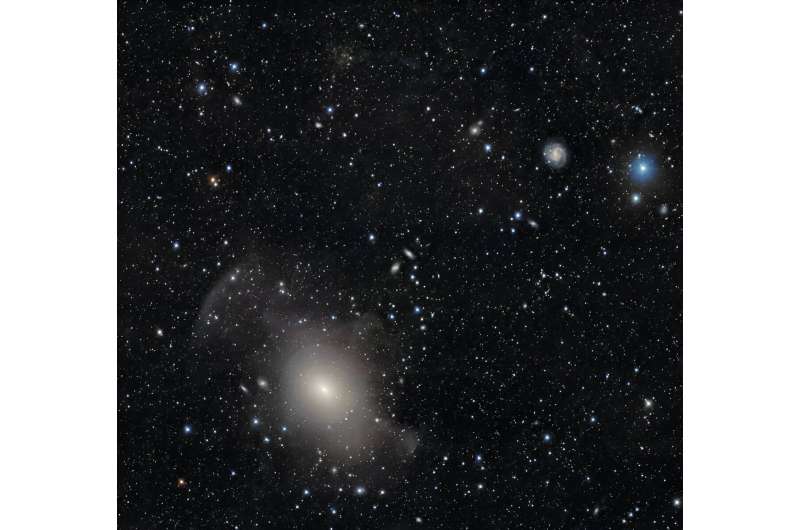
Much like humans, galaxies are shaped by the environment in which they form. While no two are exactly alike, they can be divided into three main types: spiral, elliptical and irregular. Of these types, elliptical galaxies are the largest and are thought to evolve out of galactic collisions and mergers between spirals. About one-tenth of elliptical galaxies are classified as shell galaxies, characterized by the concentric shells that make up their galactic haloes.
A striking example of this type of galaxy is NGC 3923, with its onion-like layers beautifully showcased in this image taken with the DOE-built Dark Energy Camera (DECam) on the Víctor M. Blanco 4-meter Telescope at Cerro Tololo Inter-American Observatory (CTIO), a Program of NSF's NOIRLab. Located in the constellation Hydra (the Serpent), NGC 3923 is about 70 million light-years away from Earth and 150,000 light-years across, making it about 50% larger than our Milky Way.
As is thought to be the story of all shell galaxies, the layered structure seen in NGC 3923 likely developed as a consequence of a merger with another, smaller spiral galaxy in the past. As they merged, the larger galaxy's gravitational field slowly peeled off stars from the smaller galaxy's disk. Those stars began to gradually mix with the larger galaxy's outer halo, forming concentric bands, or shells. A simple analogy is adding a drop of food color to a bowl of batter that you're slowly stirring. The drop gets stretched out in a spiral that remains visible for a long time before completely mixing.
-
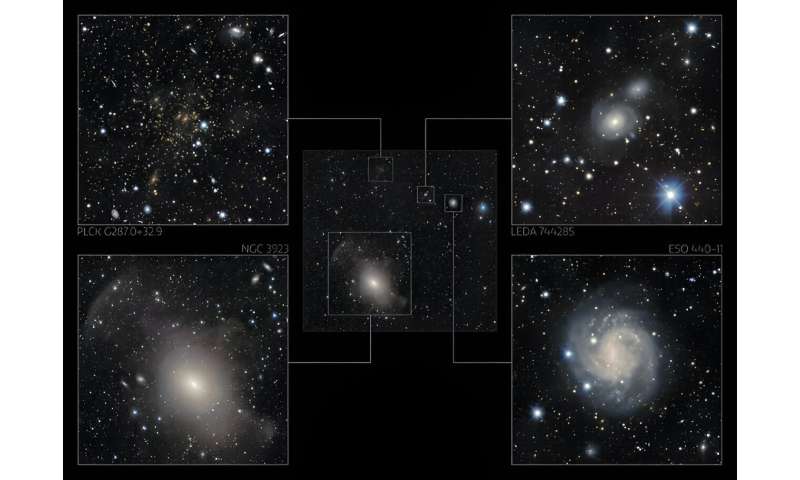
Excerpts of the galaxy-rich image showcasing NGC 3923 taken by the US Department of Energy’s (DOE) Dark Energy Camera mounted on the National Science Foundation’s (NSF) Víctor M. Blanco 4-meter Telescope at Cerro Tololo Inter-American Observatory in Chile, a Program of NSF’s NOIRLab. Credit: DESI Legacy Imaging Surveys/LBNL/DOE & KPNO/CTIO/NOIRLab/NSF/AURA; Image processing: T.A. Rector (University of Alaska Anchorage/NSF’s NOIRLab), M. Zamani (NSF’s NOIRLab), R. Colombari (NSF’s NOIRLab) & D. de Martin (NSF’s NOIRLab) -
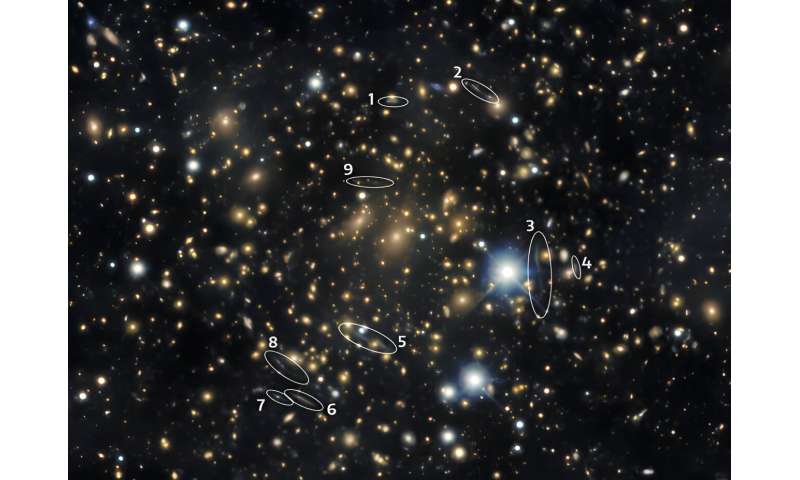
Close-up of gravitational lenses with annotations. Credit: DESI Legacy Imaging Surveys/LBNL/DOE & KPNO/CTIO/NOIRLab/NSF/AURA; Image processing: T.A. Rector (University of Alaska Anchorage/NSF’s NOIRLab), M. Zamani (NSF’s NOIRLab), R. Colombari (NSF’s NOIRLab) & D. de Martin (NSF’s NOIRLab)
The shells of NGC 3923 make the galaxy quite exceptional. Not only does it have the largest known shell of all observed shell galaxies, but it also has the largest number of shells and the largest ratio between the radii of the outermost and innermost shells. A 2016 study determined that NGC 3923 could be made up of as many as 42 distinct shells, with the outermost layers having been created first, followed by the innermost layers as the galaxies' celestial dance slowed.
-
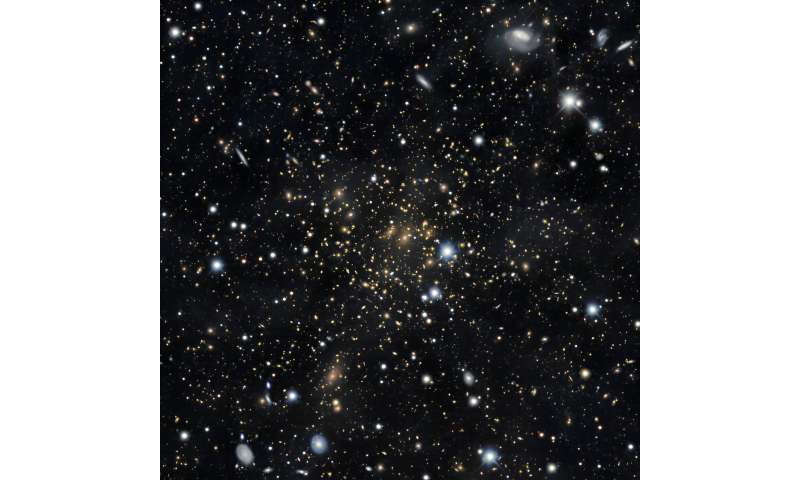
PLCK G287.0+32.9 Gravitational Lensing. Credit: DESI Legacy Imaging Surveys/LBNL/DOE & KPNO/CTIO/NOIRLab/NSF/AURA; Image processing: T.A. Rector (University of Alaska Anchorage/NSF’s NOIRLab), M. Zamani (NSF’s NOIRLab), R. Colombari (NSF’s NOIRLab) & D. de Martin (NSF’s NOIRLab) -
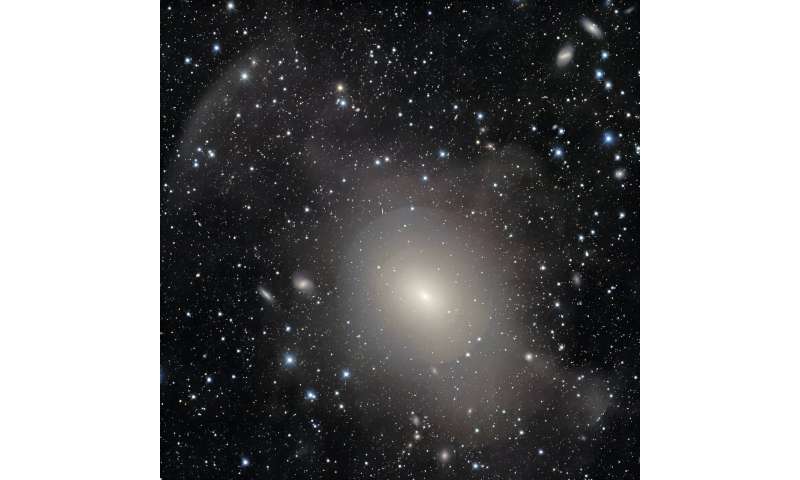
NGC 3923. Credit: DESI Legacy Imaging Surveys/LBNL/DOE & KPNO/CTIO/NOIRLab/NSF/AURA; Image processing: T.A. Rector (University of Alaska Anchorage/NSF’s NOIRLab), M. Zamani (NSF’s NOIRLab), R. Colombari (NSF’s NOIRLab) & D. de Martin (NSF’s NOIRLab)
Another notable characteristic of NGC 3923 is that its shells are much more subtle than those of other shell galaxies. Its shells are also interestingly symmetrical, while other shell galaxies are more skewed. These uncommon features are a sublime example of the unique structures that galaxies can embody depending on their specific evolutionary conditions.
While NGC 3923 is certainly the main attraction in this expansive, 250-megapixel image, the longer one spends perusing the glittering field the more cosmic treasures can be found. Among the thousands of galaxies and countless foreground Milky Way stars speckling this image are the face-on spiral galaxies LEDA 744285 and ESO 440-11. Near the top of the image is the extremely large gravitational lens around galaxy cluster PLCK G287.0+32.9.
-
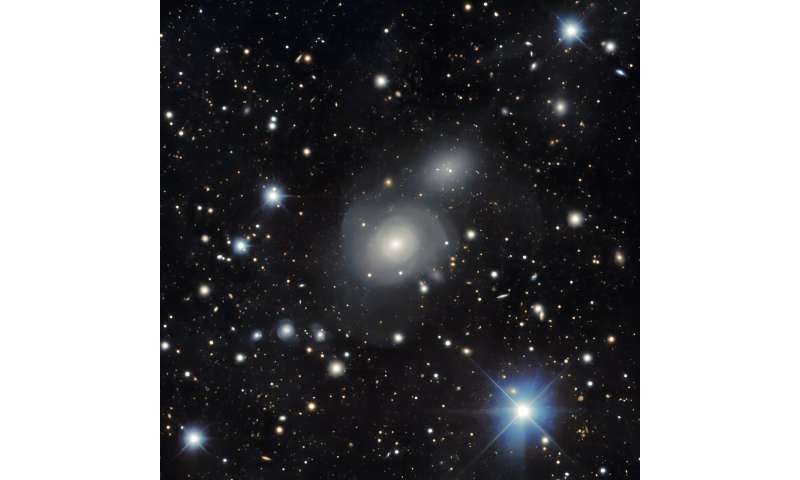
Face-on spiral galaxy LEDA 744285. Credit: DESI Legacy Imaging Surveys/LBNL/DOE & KPNO/CTIO/NOIRLab/NSF/AURA; Image processing: T.A. Rector (University of Alaska Anchorage/NSF’s NOIRLab), M. Zamani (NSF’s NOIRLab), R. Colombari (NSF’s NOIRLab) & D. de Martin (NSF’s NOIRLab) -
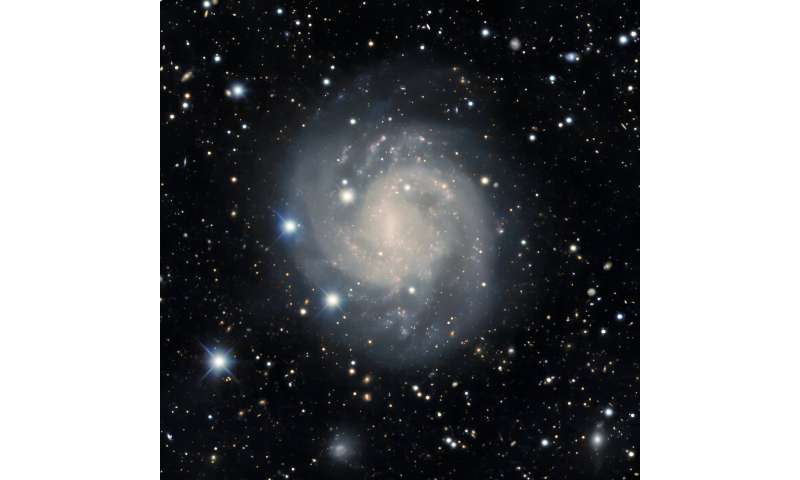
Face-on spiral galaxy ESO 440-11. Credit: DESI Legacy Imaging Surveys/LBNL/DOE & KPNO/CTIO/NOIRLab/NSF/AURA; Image processing: T.A. Rector (University of Alaska Anchorage/NSF’s NOIRLab), M. Zamani (NSF’s NOIRLab), R. Colombari (NSF’s NOIRLab) & D. de Martin (NSF’s NOIRLab)
Discussed in scientific journals since the 1930s, gravitational lenses are predicted by Einstein's General Theory of Relativity, which states that a massive object, such as a cluster of galaxies, can warp spacetime. Narrow arc-like shapes located around clusters of galaxies were first found in 1989 by NOIRLab (then NOAO) astronomer Roger Lynds and Stanford colleague Vahé Petrosian using the Nicholas U. Mayall 4-meter Telescope at Kitt Peak National Observatory, a Program of NSF's NOIRLab. These extragalactic properties were interpreted as the result of strong gravitational lensing from distant galaxies in the background.
Indeed, when zoomed into this image, a handful of galaxies can be seen stretched out and distorted under the gravitational influence of dark matter, the mysterious substance found concentrated around clusters of galaxies. Gravitational lenses allow astronomers to explore the most profound questions of our universe, including the nature of dark matter and the value of the Hubble constant, which defines the expansion of the universe.
This image was created using data from the DESI Legacy Imaging Surveys.
Provided by NOIRLab





















